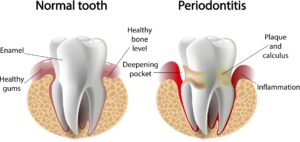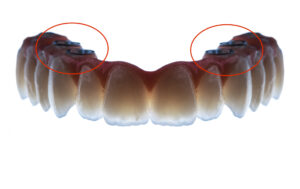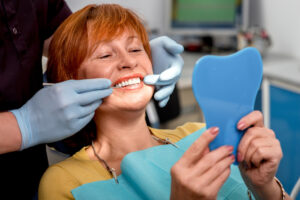Header logo
header top contact widget
Asheville Periodontist
Serious Disease Connections To Oral Health
Posted on Oct 12, 2021 by William J. Claiborne, DDS MS
As an Asheville periodontist, I have advanced skills in the diagnosis and treatment of all stages of periodontal (gum) disease. Over the years, I have closely followed the extensive amount of research that associates the health of the mouth with overall health. There are amazing connections between the bacteria of gum disease to severe (and even deadly) health problems far beyond the mouth.
Periodontal disease is an infection that destroys gum tissues and the structures that support teeth. As gum tissues are attacked and weakened, the bacteria of gum disease can enter the bloodstream through tears in diseased tissues.
This infectious bacteria is capable of causing inflammatory reactions elsewhere in the body. Systemic inflammation is the now-known epicenter of a number of major health problems, including heart disease, stroke, high blood pressure, diabetes, arthritis, impotency and more.
You may be interested to read about just some of the correlations between oral bacteria of gum disease and…
Dementia & Alzheimer’s disease: Gum disease occurs when infection of the oral tissues develops. It causes bleeding gums, putrid breath odor, loose teeth, and even tooth loss. Oral bacteria and the inflammatory molecules that develop can enter the bloodstream, making their way to the brain. Previous lab studies have suggested that this is a potential risk factor in the sequence of events that lead to dementia.
https://www.nia.nih.gov/news/large-study-links-gum-disease-dementia
In data from the National Health and Nutrition Examination Survey (NHANES), different age groups at baseline, with up to 26 years of follow-up, analyzed over 6,000 study participants. The researchers examined whether gum disease and infectious oral bacteria were linked to dementia and deaths.
Participants had received a dental exam for signs of gum disease as well as blood tests for antibodies against causative bacteria. The team analyzed antibodies against 19 oral bacteria for an association with the diagnosis of Alzheimer’s, diagnosis of any kind of dementia, and death from Alzheimer’s. Of these 19, Porphyromonas gingivalis is the most common culprit of gum disease. In fact, a recent study suggests that plaques of beta-amyloid protein, a major hallmark of Alzheimer’s disease, may be produced as a response to this infection.
https://pubmed.ncbi.nlm.nih.gov/26474422/
Erectile Dysfunction: In the U.S., an estimated 18 percent of males have erectile dysfunction. Men over the age of 70 are more likely to have ED compared to 5 percent between ages 20 – 40.
Studies have shown an association between gum disease and pancreatic cancer. From analyzed data of five studies between 2009 – 2014, the studies covered 213,000 participants aged 20 to 80.
Each study found erectile dysfunction (ED) was more common among men being treated for chronic periodontitis, particularly for those younger than 40 and older than 59. After accounting for other health factors, erectile dysfunction was found to be 2.28 times more common for men who had advanced gum disease than for men without it.
Stroke: In one study of 265 stroke patients, researchers found that patients with gum disease had twice as many strokes due to thickening and hardening of brain arteries as patients without. Additionally, patients with gum disease were three times as likely to have a stroke involving blood vessels in the back of the brain, which controls vision, coordination and other functions.
In a separate study of over 1,100 patients who had not experienced a stroke, researchers noted that 10 percent had severely blocked brain arteries. They also found that patients with gum inflammation were twice as likely to have moderately severe narrowing of brain arteries.
Pre-Term Babies: The elevated hormone levels during pregnancy create a higher vulnerability to gum disease; the reason about half of pregnant females experience swollen, red and tender gums that bleed while brushing. Known as Pregnancy Gingivitis, the gums are more susceptible to inflammation, thus more sensitive to the bacteria of gum disease.
Studies have shown that gum disease increases the risk for preterm delivery (before 37 weeks) and low birth weight babies. Gum disease also increases the risk for poor obstetrical outcomes, late miscarriage and pre-eclampsia. For example, the preterm birth rate for women without periodontal disease is approximately 11 percent compared to nearly 29 percent for females with moderate to severe gum disease.
Through tears in gum tissues, oral bacteria can enter the bloodstream. Once this bacteria reaches placental membranes, it can trigger inflammation that can cause preeclampsia or labor.
Arthritis: For decades, it was perceived that RA (rheumatoid arthritis) patients had such a high risk of gum disease due to poor oral hygiene because of dexterity problems with using a toothbrush. However, more recent studies now show that gum disease is actually a risk factor for arthritis.
While genetic factors certainly contribute to greater RA susceptibility, the true source has been determined to be inflammatory reactions. This inflammation is triggered primarily by bacterial infections, with oral bacteria being a significant contributor to inflammatory arthritis.
They found that people with severe periodontal disease also had severe rheumatoid arthritis. Patients with the most plaque, bleeding and gum tissue breakdown had worse RA by all measures, including disease activity and inflammatory markers. Other studies have found that even with treatment, RA patients with periodontitis continue to have worse arthritis symptoms and are 50% less likely to be in remission.
The relationship between gum disease and arthritis isn’t seen only in adults. Kids with juvenile idiopathic arthritis (JIA) have inflammatory mouth bacteria not found in their healthy peers. Different types of bacteria seem to correspond to specific aspects of JIA. Some are associated with higher disease activity and others with a greater number of affected joints.
https://www.arthritis.org/health-wellness/about-arthritis/understanding-arthritis/mouth-bacteria
Pancreatic Cancer: Research reveals that the bacteria of gum disease may contribute to a higher risk of pancreatic cancer. Through a cancer prevention and screening study, the National Cancer Institute and American Cancer Society studied oral samples. Their findings showed notably higher levels of two types of oral bacteria in study participants with pancreatic cancer. One bacteria was found to create a 50 percent increased risk for pancreatic cancer and a second bacteria led to a 59 percent greater likelihood.
The results indicated a significantly positive association between periodontal disease and the risk of pancreatic cancer.
Although I could go on and on citing studies and research findings, I think you get the picture. The need for good oral health is indisputable.
Signs and symptoms of gum disease are gums that bleed when brushing, frequent bad breath, tender gums that turn red in color, swollen gums, receded and sensitive gums. If you have any of these, please know that gum disease will only worsen without treatment. It is also the leading cause of adult tooth loss.
For an examination, or to begin with a consultation, call 828-274-9440.
Postponing Dental Care Can Be Expensive
Posted on Sep 29, 2021 by William J. Claiborne, DDS MS
Most of us have seen the movie, “Gone With The Wind,” It’s pretty hard to forget the last line of Scarlet O’Hara: “I’ll think about that tomorrow.”
Procrastination is something we all do, some more than others. We all tend to “back burner” things we don’t want to do. As a periodontal dental specialist, I’m guilty of this on occasion.
However, I see a number of patients who have developed periodontal (gum) disease because they delayed or postponed dental care; care that would have easily helped them avoid the problems associated with it.
The reason 6-month dental check-ups are so beneficial is in their ability to give patients a twice-a-year clean slate in oral wellness. During this time, the dentist and hygienist can examine the mouth for signs of abnormal wear, bite alignment, and point out areas that need extra attention in oral hygiene routines at home. (This is especially true for people who have crowded or crooked teeth, as bacteria can easily accumulate in these tight angles.)
This dental appointment also allows the hygienist to remove plaque or tartar that has formed since the patient’s last check-up. Both are accumulations of oral bacteria, which will continue to reproduce rapidly without regular removal.
Plaque starts the process. It is the sticky film you probably feel on teeth when you first wake up. This film is actually a layer of bacteria that has rapidly reproduced during the night. (If you snore or breathe through your mouth during sleep, oral dryness can accelerate the rate of reproduction even more.)
Although it is more obvious on teeth, the film of plaque also coats the gum tissues and tongue. If not thoroughly removed within 48 hours, these bacteria amass to such a level that the plaque hardens. This is known as tartar.
Tartar typically forms between teeth and at the base of teeth. This is why daily flossing is helpful. It scrapes off plaque in areas the toothbrush may not reach, or may not be cleaning sufficiently.
Once tartar forms, however, it can no longer be removed by brushing and flossing. This is what the hygienist is picking at and scraping off teeth during dental cleanings. If not removed, these bacterial colonies continue to grow. And bacteria breed at an amazingly fast pace.
Just how quickly can these oral bacteria amass?
According to information shared by RDH Magazine: (https://www.rdhmag.com/infection-control/water-safety/article/16404976/oral-bacteria-how-many-how-fast)
“some species of oral bacteria can double their numbers every 20 minutes under ideal conditions in a Petri dish.”
This means that one million bacteria can grow to 14 million within an hour. Accumulated bacteria can even be seen in the mouth as a white coating on the tongue. The back of the tongue is typically whiter in color since tooth brushing doesn’t reach there and dislodge embedded bacteria. (This is why it’s important to brush your tongue every day when toothbrushing, or use a tongue scraper.)
Tartar holds such a high number of bacteria that these organisms can cause damage to teeth. They bore into tooth enamel and eat away at oral tissues.
Bacteria are ramped up by foods we eat. They especially love lingering food particles caught between teeth and foods containing sugar. (This is yet another reason to floss daily.)
Initially, gum disease causes tender gums that may be swollen. They may bleed when brushing, which is typically noticed when spitting. Symptoms may also include frequent bad breath, gums that are more red in color than a healthy pink, and soreness when brushing or flossing.
Keep in mind, this is just the beginning. This stage is known as Gingivitis and is just a prelude of what’s to come. If prompt measures are taken as soon as these symptoms arise, Gingivitis may be overcome without requiring dental treatment. Thorough brushing (twice a day, at least), daily flossing, and keeping the mouth moist with plain water may be effective in overcoming Gingivitis.
If not resolved, Gingivitis can progress to periodontal disease. During this level of gum disease, breath odor is persistently bad. The gums bleed easily when brushing and are more red in color. Gums are sore and tender. As the disease worsens, the gums become spongy and pus pockets may form at the base of teeth.
Eventually, the bone tissues and gums become so damaged by periodontal bacteria that some teeth may loosen. This stage is periodontitis and is an infectious disease that can cause devastation far beyond the mouth.
Periodontal disease is the nation’s number one cause of adult tooth loss.
These potent bacteria can enter the bloodstream, creating inflammatory reactions that can activate or worsen a number of serious health problems. These include heart disease, stroke, high blood pressure, diabetes, arthritis, preterm babies, some cancers, impotency, erectile dysfunction, and Alzheimer’s disease.
That’s a pretty serious list. As research continues to study the far-reaching effects of these infectious bacteria, the list seems to lengthen more.
Have you been putting off dental care? Treating advanced gum disease and replacing teeth are both pretty involved procedures.
In many cases, I’ve found patients avoid or delay dental care due to feeling it is too expensive or having fear associated with dental visits. Yet, the price (in time and money) from not properly caring for oral health is steep in many ways.
The devastation caused by these bacteria can be easily avoided with simple measures at home and 6-month dental visits. An at-home dental care regimen should only require about 5 minutes per day. A dental check-up usually takes about an hour.
If you are very uncomfortable during dental cleanings, tell your hygienist. He or she may be able to provide a pre-treatment rinse or a topical swab for more sensitive areas. (Just know that until your gums get into healthier shape, it is the inflammation caused by oral bacteria that makes them more sensitive.)
The obstacles that typically prevent patients from receiving the care they need are:
Cost: Most dental practices offer payment plans that are interest-free with no down payment required. If you don’t have dental insurance, ask about any discounts they may offer or consider using a credit card.
Dental fear: In our Asheville periodontal dental office, we offer both oral and I.V. sedation (“twilight sleep”), if desired. We understand that many adults have anxiety or fear when it comes to dental treatment. Our entire staff is committed to providing all patients with a gentle touch, a respectful environment, and compassionate care.
Embarrassment or feeling a smile is “hopeless”: We see many adults who have “bombed out” mouths. This can happen for a number of reasons. Here, we are a “judgement-free” perio office and treat every patient as we would want our loved ones treated. And, no smile is hopeless. We have a great many patients who are testaments to that!

For patients who have lost natural teeth, for whatever reason, a periodontist has advanced skills in the diagnosis and placement of dental implants. Once your gums are restored to a healthy state, we can discuss that tooth replacement option, if you like.
As with most things in life, delaying care is a sure recipe to get deeper in the problem. Be committed to your daily oral care routine and keeping regular dental appointments. If you are having symptoms associated with any stage of gum disease, however, I am a dental specialist in treating even advanced levels.
Call 828-274-9440. A referral is not needed.
Dental Implants Not ‘One Size Fits All’
Posted on Sep 21, 2021 by William J. Claiborne, DDS MS
A periodontist specializes in the diagnosis and placement of dental implants, in addition to the treatment of all stages of periodontal disease.
For people who are considering dental implants to replace teeth, this level of expertise provides greater reassurance of successful treatment outcomes. A periodontist can also offer patients with a wider choice of implant systems.
How can patients have more dental implant options through a periodontist?
When general dental offices offer dental implants, some general dentists offer implant selection and placement along with the restoration of the implant. (“Restoration” refers to the replacement crown that is attached to the implanted portion.)
Although generalists complete training in dental implants, most courses are offered by particular implant manufacturers. This means that the course focuses on the systems available through this one maker, which may or may not include the one most appropriate for your individual needs.
This is why most generalists refer the placement portion to a periodontal specialist. For their patient, this can mean a higher level of success, especially for complex needs.
For example, a patient who is missing a lot of bone mass (due to missing natural teeth for many years) benefits from the specialized skills of our Asheville periodontal office. A periodontist can incorporate bone rebuilding procedures into treatment to a proper depth. This specialist can help to restore bone that has occurred in the mandible (lower jaw) or maxilla (upper jaw), which may also require a sinus lift.
Another example is a patient who has lost teeth due to periodontal (gum) disease. Because a periodontist combines advanced skills in treating gum disease as well as in dental implants, these patients have an added advantage when it comes to treatment success.
For many reasons, dental implants have become the preferred tooth replacement option. There are over 40 different implant systems, each designed to accommodate various challenges and preferences. Some of the more common types include:
Traditional Dental Implants: In this process, dental implant treatments is done in a couple of stages. In the first stage, placement of each implant is performed. This involves small incisions in pre-selected placement points. In our Asheville periodontal dental office, these points are determined through computerized imaging, taking the guesswork out of the depth and angle of each implant placed. Once the implant is in proper position, the gum tissue is closed over the implant sites.

Several implants can often hold a full arch of teeth
The second stage involves a “healing period” of 3 – 6 months. During this phase, the bone grows around the implant(s) to secure each in place. The patient’s denture or partial denture can be comfortably worn during this time. This process is known as osseointegration, which describes the jaw bone growing around the implanted portion. This is what secures the implant so it provides stable, dependable biting and chewing strength.
After osseointegration is complete, the implant sites are uncovered and a post is positioned in the implant’s interior. Onto the posts, replacement teeth are attached. Once the final teeth are secured, patients can enjoy their confident smile along with the biting and chewing comfort like that of natural teeth.
Non-Removable Teeth Attached To Implants: In the past, the more affordable ‘full arch’ systems were typically those designed to support removable teeth. (An ‘arch’ is a full arrangement of all upper or all lower teeth.) However, some people feel removable teeth are too similar to the denture they wish to replace. Although firmly secured, the chore of having to remove teeth to clean them is a task many people want to eliminate.
A number of affordable implant systems are now available, designed to provide non-removable options that are more affordable. For example, the All On 4 dental implant system is made to support non-removable teeth on just 4 implants. With the implanted portions placed at unique angles, these longer implants can fully distribute biting and chewing forces. Another advantage of All On Four is their ability to be placed in minimal bone.
This is good news for people who are long-time denture wearers and were told they have too little bone to support implants. Or, they may have been advised to have bone grafts to rebuild the bone to an adequate height. This adds time and expense to implant treatment. Often, the All On 4 design is able to overcome this obstacle.
‘Same-Day’ Dental Implants: Advancements in dental implant systems and technology have evolved into implant placement and teeth attachment that can be accomplished in a single day. Some implant designs can position implants in the jaw bone in a way that they are able to support replacement teeth immediately.
With the replacement teeth created prior, the teeth may be attached without delay. In some cases, a previously-made denture or partial can be reconfigured to attach to newly placed implants. However, mounting replacement teeth to a just-placed implant isn’t wise for certain situations. This option should be diagnosed and performed by an experienced, skilled and highly-trained dental specialist in order to achieve a successful outcome. While “same-day” procedures can sound appealing, choose care where your individual needs are a priority.
Modern implant dentistry is successful, safe, dependable and can provide nearly immediate benefits. Our office enjoys a reputation for being on the cutting edge of implant dentistry’s techniques, technology and materials. This assures our patients of care that minimizes discomfort and treatment time while optimizing their final results.
Dental implants are designed to last a lifetime, making them an excellent investment. They are the closest thing to the natural teeth you once had, restoring the ability to bite, chew, speak and laugh confidently.
Over the years, I have been a witness to the transformations many implant patients undergo after treatment. They seem to smile and laugh more, become more social, and focus on their oral and overall health to a greater extent.
The type of dental implant best suited for you can be determined after an examination and review of x-rays (we use Cone-Beam digital imaging). Call 828-274-9440 to begin with a private, no obligation consultation to discuss your best options.
Please know that, if cost is a concern, payment plans can help you enjoy your beautifully restored smile while making easy monthly payments. Too, in many cases, an implant is not needed to replace each missing tooth. Often, when several teeth are missing in one area, one or two implants can support a “bridge” of several teeth. This curtails the treatment costs by reducing the number of implants needed.
If dental fear or anxiety is a concern, please mention this during our consultation. In our Asheville office, our entire team strives to provide a respectful, compassionate environment. We offer oral and I.V. sedation (twilight sleep) for nearly any procedure as well as a gentle touch at every visit.
Misconceptions Of Oral Health
Posted on Sep 14, 2021 by William J. Claiborne, DDS MS
As a periodontal dental specialist, I have advanced skills in the treatment of gum disease and dental implants. In my specialty, I see patients who have various issues related to oral health. Some of these can be resolved with minor treatment and others require more involved procedures.
In many cases, however, a factor in the severity of certain issues occur because it was assumed the problem would resolve itself. Some patients have also assumed that certain signs or symptoms were “normal”.
The health of the mouth is largely reliant on the condition of the gum tissues. This moist, soft covering of tissues is a protective blanket for the structures underneath. Gum tissues protect the structures that support natural teeth as well as their roots.
Yet, because the gums are not visible as are teeth, it is easy to “back burner” problems. Some of these problems DO resolve on their own. However, in too many cases, what is set aside eventually requires extensive treatment; treatment that may have easily been avoided with early care.
I’d like to address some of the more common issues I see that are misconceptions…
Assuming seeing blood in the sink when brushing teeth is normal: Srubbing teeth so rigorously that they bleed is not a sign of doing a good job. This action not only wears away precious tooth enamel, it wears away the gum tissues that wrap the base of teeth.
Gums that bleed when brushing are also a symptom of periodontal (gum) disease. In addition, gum disease can cause tenderness, swelling or frequent bad breath. Without treatment, gum disease will progress further. This is why it is the nation’s leading cause of adult tooth loss.
Protect tooth enamel and gum tissues by using a soft to medium bristled toothbrush and a non-abrasive toothpaste (never substances such as baking soda). Using a swirling motion (rather than going back-&-forth), avoid applying too much pressure. Make sure that the tips of the bristles are contacting the surfaces of teeth. Hint: If you notice your toothbrush’s bristles flay outward after a month or so of use, you’re pressing too hard.
Ignoring gum recession: The gums are designed to snugly wrap the base of each tooth, serving to seal out bacteria. Although the aging process and oral dryness can shrink gum tissues, a common cause of receded gums is gum disease.
Gum recession is what causes sensitivity to hot, cold or the bristles of a toothbrush. Oftentimes, a bite of ice cream can send a jolt of pain. Even without the sensitivity, recession can leave the darker tooth root areas exposed. This leaves the tooth vulnerable to damage by oral bacteria.
Ignoring frequent bad breath: Bad breath is typically a by-product of bacteria build up. Although certain medical conditions can contribute to bad breath, keeping oral bacteria levels under control will minimize the risk of having smelly breath odor.
Saliva is what controls a significant amount of oral bacteria. However, without regular brushing and flossing, bacteria can quickly exceed what saliva is able to manage.
This is why it is important to brush twice daily and floss daily. These small tasks help to control bacteria by removing the sticky buildup of plaque. If not removed, plaque hardens into what is known as tartar. Tartar is a destructive mass of bacteria that can no longer be brushed or flossed away.
Having gum depth measurements of four and over: During regular check-ups, hygienists check gum health by gently using a probe along the base of each tooth. This is done to indicate loosening of gum tissues on the front and back sides of teeth. A good check-up will have no depth measurement higher than a three.
If the depth measures a 4 or 5 (or higher), the gums are not sealing out oral bacteria sufficiently. This may be an indication of gum disease. The higher the number, the more advanced it is.
Assuming tooth loss is normal: Some people assume tooth loss is a natural part of the aging process. This is not accurate. Adults lose teeth due to accidents, decay or (most often) gum disease.
Occasionally, a tooth that needs crowning or filling is deemed a “problem” tooth. This causes some people to want the tooth removed rather than repaired. Yet, missing tooth roots in the jaw bone triggers a process of bone shrinkage. This is known as resorption.
Resorption occurs without the stimulating presence of the tooth root. As the bone declines in height and width, neighboring teeth can also be affected. Adjacent tooth roots in areas of insufficient bone structure are at a higher risk of cavities, gum disease, and tooth breaks or fractures. Statistics show that a tooth adjacent to a missing tooth is most likely the next to be lost.
When a tooth must be removed, we recommend replacing it with a dental implant. Because an implant is positioned in the bone, it helps halt bone loss and protect the well-being of neighboring teeth.
Not reacting to spots on the tongue, lips or inside the cheek: People occasionally develop canker sores inside the mouth. These can be caused by stress or having an acidic diet. Both should go away within ten days or so.
Any spot or change inside the mouth or throat that does not resolve on its own within two weeks should be seen immediately. This may be a sign of oral cancer and may appear as a red or white spot. Or, it may cause hoarseness or difficulty swallowing. If caught early, oral cancer can be successfully treated. Acting promptly is highly important as it can lead to disfiguring treatment and be even deadly.
Assuming oral health is contained in the mouth: It has been shown that having good oral health is an advantage to having good overall health. The potent bacteria of gum disease can enter the bloodstream and cause inflammatory reactions elsewhere in the body. Research has correlated a number of serious health problems with the infectious bacteria of gum disease. These include heart disease, stroke, some cancers, Alzheimer’s disease and arthritis.
As an Asheville periodontist, I believe that adults can improve their oral health by being informed patients and committed to having a healthy smile.
A good resource on maintaining good oral health is the web site of the American Academy of Periodontology: www.perio.org (go to Patient Resources). Or, call our Asheville periodontal dental office at 828-274-9440.
Recent Posts
Categories
Archives
- September 2024
- August 2024
- July 2024
- June 2024
- May 2024
- April 2024
- March 2024
- February 2024
- January 2024
- December 2023
- November 2023
- October 2023
- September 2023
- August 2023
- July 2023
- June 2023
- May 2023
- April 2023
- March 2023
- February 2023
- January 2023
- December 2022
- November 2022
- October 2022
- September 2022
- August 2022
- July 2022
- June 2022
- May 2022
- April 2022
- March 2022
- February 2022
- January 2022
- December 2021
- November 2021
- October 2021
- September 2021
- August 2021
- July 2021
- June 2021
- May 2021
- April 2021
- March 2021
- February 2021
- January 2021
- December 2020
- November 2020
- October 2020
- September 2020
- August 2020
- July 2020
- June 2020
- May 2020
- April 2020
- March 2020
- February 2020
- January 2020
- December 2019
- November 2019
- October 2019
- September 2019
- August 2019
- July 2019
- June 2019
- May 2019
- April 2019
- March 2019
- February 2019
- January 2019
- December 2018
- November 2018
- October 2018
- September 2018
- August 2018
- July 2018
- June 2018
- May 2018
- April 2018
- March 2018
- February 2018
- January 2018
- December 2017
- November 2017
- October 2017
- September 2017
- August 2017
- July 2017
- June 2017
- May 2017
- April 2017
- March 2017
- February 2017
- January 2017
- December 2016
- November 2016
- October 2016
- September 2016
- August 2016
- July 2016
- June 2016
- May 2016
- April 2016
- March 2016
- February 2016
- January 2016
- December 2015
- November 2015
- October 2015
- September 2015
- August 2015
- July 2015
- June 2015
- May 2015
- April 2015
- March 2015
- February 2015
- January 2015
- December 2014
- November 2014
- October 2014
- September 2014
- August 2014
- July 2014
- June 2014
- May 2014
- April 2014
- March 2014
- February 2014
- January 2014
- December 2013
- November 2013
- October 2013
- September 2013
- August 2013
- July 2013
- June 2013
- May 2013
- April 2013
- March 2013
- February 2013
- January 2013
- December 2012
- November 2012
- October 2012
- September 2012
- August 2012
- July 2012
- June 2012


